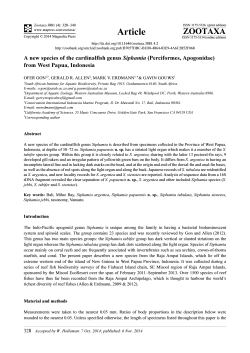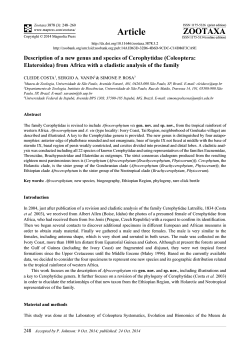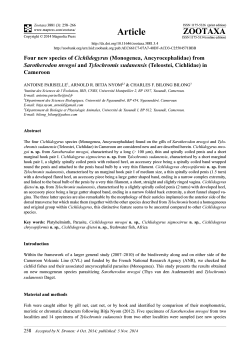
Preview - Magnolia Press
Zootaxa 3900 (2): 223–242 www.mapress.com /zootaxa / Copyright © 2014 Magnolia Press Article ISSN 1175-5326 (print edition) ZOOTAXA ISSN 1175-5334 (online edition) http://dx.doi.org/10.11646/zootaxa.3900.2.3 http://zoobank.org/urn:lsid:zoobank.org:pub:69A87C28-ADCB-42F3-8CB4-5C0EDC2A882C A new colorful species of Pristimantis (Anura: Craugastoridae) from the eastern flank of the Cordillera Central in Colombia DIEGO A. RIVERA-PRIETO1, MAURICIO RIVERA-CORREA1,2 & JUAN M. DAZA1 1 Grupo Herpetológico de Antioquia, Instituto de Biología, Universidad de Antioquia, Calle 67 # 53–108, Bloque 7–121, A.A. 1226, Medellín, Colombia. E–mails: DRP, dieriv22@gmail.com; JMD, jumadaza@gmail.com 2 Division Herpetología, Museo Argentino de Ciencias Naturales "Bernardino Rivadavia" Av. Angel Gallardo 470, C1405DJR, Buenos Aires, Argentina. E–mail: mauriciorivera79@gmail Abstract We describe a new species of Pristimantis from the humid forests on the eastern flank of the northern Cordillera Central in Colombia (6º 23' 19.3554" N, 75º 1' 24.0594" W; ca. 1150 m.a.s.l.). Pristimantis jaguensis sp. nov. is characterized by an extraordinary variation in color and is readily distinguished from congeneric species by lacking nuptial pads, discoidal fold and conical calcar tubercles; flanks and belly white to cream without blotches as well as iris yellow ocher to copper with thick brown reticulation and cream sclera. Molecular phylogenetic analyses recovered the new species in a clade with species mostly distributed in Ecuador. Our finding suggests that new taxa can still be discovered in the Middle Magdalena River valley of Colombia despite the extensive sampling this region has received during the last decades. Key words: Andes, Department of Antioquia, phylogenetic position, taxonomy Resumen Describimos una nueva especie de Pristimantis de los bosques húmedos del flanco oriental del norte de la Cordillera Central en Colombia (6º 23' 19.3554" N, 75º 1' 24.0594" W; 1150 m.s.n.m.). Pristimantis jaguensis sp. nov. se caracteriza por poseer una extraordinaria variación en color y es fácilmente distinguible de las especies cogenéricas por tener el vientre y los costados de blanco a crema sin manchas, iris amarillo ocre a cobre con retículos marrón y esclerótica crema; además por carecer de almohadillas nupciales, pliegues discoidales y tubérculos calcares. Análisis filogenéticos con datos moleculares sugieren que la nueva especie es parte de un clado que incluye miembros con distribución geográfica principalmente en Ecuador. La especie aquí descrita indica que nuevas especies pueden ser descubiertas a pesar del extensivo muestreo en el valle medio del Río Magdalena de Colombia en las últimas décadas. Palabras clave: Andes, Departamento de Antioquia, posición filogenética, taxonomía Introduction The department of Antioquia, located in northwestern Colombia with an area of 63.612 km2 (Callejas 2012) and representing the 5.6% of the Colombian territory, is the region with the highest diversity of amphibians in the country with approximately 224 known species (IUCN 2011). The complex Andean orogeny, formed by the Cordillera Occidental and Cordillera Central, and the Atrato, Cauca and Magdalena river valleys, in addition to the biogeographic position connecting Central and South America, have played a critical role in the process of diversification and endemism and might be responsible of the exceptional amphibian richness. However, only 20% of the territory of the department of Antioquia has been thoroughly sampled (GHA 2007), suggesting that many species are yet to be discovered and formally described. Pristimantis Jiménez de la Espada is the most diverse genus of amphibians in the neotropics (Hedges et al. 2008, Frost 2014). With about 45 species, Antioquia harbors 25% of the Pristimantis in Colombia (IUCN 2011). Accepted by J. Padial: 11 Nov. 2014; published: 22 Dec. 2014 223 Discussion The Cordillera Central represents one the main biogeographic regions in Colombia due to its high level of endemism (Lynch et al. 1997). Explorations in the last two decades on the eastern flank of the Cordillera Central have uncovered many unnamed species, suggesting that frog diversity in this part of Colombia is vastly underestimated (Lynch & Rueda-Almonacid 1999). However, a narrow transect along this flank of the Cordillera constitutes the only well-sampled area in the region (Lynch & Rueda-Almonacid 1999). North of this transect is the type locality of P. jaguensis and of two additional species named a decade ago: Pristimantis fallax (Lynch & Rueda-Almonacid 1999) and Diasporus anthrax (Lynch 2001) and many areas potentially harboring unnamed species remain to be explored. This region is not only relevant because of its level of endemism, but also because it constitutes the transition zone between the humid forests of the Magdalena River valley and the Tropical Andes. A better exploration of the area is necessary to characterize and understand the biogeography of this interesting region. Phylogenetic relationships within Pristimantis are still largely unknown. Despite major recent advances (Hedges et al. 2008; Pyron & Wiens 2011; Pinto et al. 2012; Padial et al. 2014), the lack of adequate taxon sampling and the high level of cryptic species and taxonomic problems in this highly diverse clade precludes adequate biogeographic inferences and generalizations regarding the diversification process in this group. However, what is clear from previous studies is that most morphological groups (e.g. Lynch 1976) are not monophyletic. For instance, the sister clade to Pristimantis jaguensis is a group that includes representatives of three phenetic groups (P. orcesi, P. devillei and P. unistrigatus groups). Comparisons based on these groups and assignments of new species to any of these are useless, as it does not provide any meaningful information about relatedness or character evolution. What can be deduced from our phylogeny is that the sister clade of P. jaguensis includes species that are distributed mostly in Ecuador. However, the low number of species from the Choco and the Colombian Andes available in phylogenetic studies hampers a rigorous assessment of the phylogenetic relationships of the new species and its historical biogeographic affinities. Indeed, the long branch leading to P. jaguensis as well as the short internode connecting this species to its sister clade indicates that supporting evidence may be challenged by the addition of closely related taxa. As such, extensive sampling in these regions will surely help to fill these gaps in our understanding of the evolutionary history of frogs in northwestern South America. Acknowledgments Isagen provided financial support under project 47-146 and Grupo Herpetológico de Antioquia. Collecting permit was provided by the Corporación Autónoma Regional de las Cuencas del Río Negro y Nare CORNARE under Resolution 132–0158 of 2011. We thank Lina Hinestroza and Eliana Muñoz for providing information about this new taxon. We are highly grateful to Juan Valencia, Andrea Morales, Déison Sanchez, Olimpo Quintero, Juan Comeloro for their assistance in the field. For comments that largely improved the manuscript we thank J.M. Padial and an anonymous reviewer. CONICET - Argentina, provides postdoctoral Fellowships support to MRC. References Boulenger, G.A. (1899) Descriptions of new reptiles and batrachians collected by Mr. P. O. Simons in the Andes of Ecuador. Annals and Magazine of Natural History, Series 7, 4, 454–457. Boulenger, G.A. (1902) Descriptions of new batrachians and reptiles from north western Ecuador. Annals and Magazine of Natural History, Series 7, 9, 51–57. Boulenger, G.A. (1908) Descriptions of new batrachians and reptiles discoverd by Mr. M.G. Palmer in south-western Colombia. Annals and Magazine of Natural History, Series 8, 2, 515–522. Callejas, R. (2012) Generalidades del Departamento de Antioquia. In: Callejas, R. & Idárraga, A. (Eds.), Flora de Antioquia. Catalogo de las Plantas Vasculares. Editorial D´Vinni, Bogotá, Colombia, pp. 11–18. Darriba, D., Taboada, G.L., Doallo, R. & Posada, D. (2012) jModelTest 2: more models, new heuristics and parallel computing. Nature Methods, 9, 1–772. http://dx.doi.org/10.1038/nmeth.2109 NEW PRISTIMANTIS FROM COLOMBIA Zootaxa 3900 (2) © 2014 Magnolia Press · 231 Drummond, A.J., Suchard, M.A., Xie, D. & Rambaut, A. (2012) Bayesian phylogenetics with BEAUti and the BEAST 1.7. Molecular Biology and Evolution, 29, 1969–1973. http://dx.doi.org/10.1093/molbev/mss075 Duarte-Cubides, F. & Cala-Rosas, N. (2012) Amphibia, Anura, Eleutherodactylidae, Diasporus anthrax (Lynch, 2001): New records and geographic distributions. Check List, 8, 300–301. Duellman, W.E. & Lehr, E. (2009) Terrestrial breeding frogs (Strabomantidae) in Peru. NTV Science, Münster, 382 pp. Edgar, R.C. (2004) MUSCLE: multiple sequence alignment with high accuracy and high throughput. Nucleic Acids Research, 32, 1792–1797. http://dx.doi.org/10.1093/nar/gkh340 Frost, D.R. (2014) Amphibian Species of the World: an Online Reference. Version 6.0. American Museum of Natural History, New York, USA. Available from: http://research.amnh.org/herpetology/amphibia/index.php (accessed 19 January 2014) GHA (2007) Estado del conocimiento de la herpetofauna de Antioquia. In: Expedición Antioquia 2013. Medellín, Colombia, pp. 1–20. Guindon, S. & Gascuel, O. (2003) A simple, fast and accurate method to estimate large phylogenies by maximum-likelihood. Systematic Biology, 52, 696–704. http://dx.doi.org/10.1080/10635150390235520 Hedges, S.B., Duellman, W.E. & Heinicke, M.P. (2008) New World direct-developing frogs (Anura: Terrarana): Molecular phylogeny, classification, biogeography, and conservation. Zootaxa, 1737, 1–182. Heinicke, M.P., Duellman, W.E. & Hedges, S.B. (2007) Major Caribbean and Central American frog faunas originated by ancient oceanic dispersal. Proceedings of the National Academy of Sciences of the United States of America, 104, 10092–10097. http://dx.doi.org/10.1073/pnas.0611051104 Ibáñez, R. & Crawford, A.J. (2004) A new species of Eleutherodactylus (Anura: Leptodactylidae) from the Darién Province, Panama. Journal of Herpetology, 38, 240–243. http://dx.doi.org/10.1670/12-03A IUCN (2011) IUCN Red List of Threatened Species. Version 2011.2. Global Amphibian Assessment Group. Available from: http://www.iucnredlist.org (accessed 15 July 2012) Lynch, J.D. (1972) Two new species of frogs (Eleutherodactylus: Leptodactylidae) from the paramos of northern Ecuador. Herpetologica, 28, 141–147. Lynch, J.D. (1976) New species of frogs (Leptodactylidae: Eleutherodactylus) from the Pacific versant of Ecuador. Occasional Papers of the Museum of Natural History, University of Kansas, 55, 1–33. Lynch, J.D. (1979) Leptodactylid frogs of the genus Eleutherodactylus from the Andes of southern Ecuador. Miscellaneous Publication. Museum of Natural History, University of Kansas, 66, 1–62. Lynch, J.D. (1980) Systematic status and distribution of some poorly known frogs of the genus Eleutherodactylus from the Chocoan lowlands of South America. Herpetologica, 36, 175–189. Lynch, J.D. (2001) Three new rainfrogs of the Eleutherodactylus diastema group from Colombia and Panama. Revista de la Academia Colombiana de Ciencias Exactas, Físicas y Naturales, 25, 287–297. Lynch, J.D. & Duellman, W.E. (1997) Frogs of the genus Eleutherodactylus (Leptodactylidae) in western Ecuador: Systematics, Ecology, and Biogeography. Natural History Museum, University of Kansas, Lawrence, Kansas, 236 pp. Lynch, J.D. & Rueda-Almonacid, J.V. (1999) New species of frogs from low and moderate elevations from the Caldas transect of the eastern flank of the Cordillera Central. Revista de la Academia Colombiana de Ciencias Exactas, Físicas y Naturales, 23, 307–314. Lynch, J.D., Ruiz-Carranza, P.M. & Ardila-Robayo, M.C. (1997) Biogeographic patterns of colombian frogs and toads. Revista de la Academia Colombiana de Ciencias Exactas, Físicas y Naturales, 21, 237–248. Padial, J., Grant, T. & Frost, D. (2014) Molecular systematics of terraranas (Anura: Brachycephaloidea) with an assessment of the effects of alignment and optimality criteria. Zootaxa 3825 (1), 1–132. http://dx.doi.org/10.11646/zootaxa.3825.1.1 Pinto-Sánchez, N.R., Ibáñez, R., Madriñán, S., Sanjur, O.I., Bermingham, E. & Crawford, A.J. (2012) The Great American Biotic Interchange in frogs: Multiple and early colonization of Central America by the South American genus Pristimantis (Anura: Craugastoridae). Molecular Phylogenetics and Evolution, 62, 954–972. http://dx.doi.org/10.1016/j.ympev.2011.11.022 Pyron, R.A. & Wiens, J.J. (2011) A large-scale phylogeny of Amphibia including over 2800 species, and a revised classification of extant frogs, salamanders, and caecilians. Molecular Phylogenetics and Evolution, 61, 543–583. http://dx.doi.org/10.1016/j.ympev.2011.06.012 Rambaut, A. & Drummond, A.J. (2007) Tracer v1.4. Available from: http://beast.bio.ed.ac.uk/Tracer (accessed on 26 Nov. 2014) 232 · Zootaxa 3900 (2) © 2014 Magnolia Press RIVERA-PRIETO ET AL. Rivero, J.A. & Serna, M.A. (1987) Tres nuevas especies de Eleutherodactylus (Amphibia, Leptodactylidae) de Antioquia, Colombia. Caribbean Journal of Science, 23, 386–399. Ronquist, F., Teslenko, M., van der Mark, P., Ayres, D.L., Darling, A., Höhna, S., Larget, B., Liu, L., Suchard, M.A. & Huelsenbeck, J.P. (2012) MrBayes 3.2: Efficient bayesian phylogenetic inference and model choice across a large model space. Systematic Biology, 61, 539–542. http://dx.doi.org/10.1093/sysbio/sys029 Santos, J.C., Coloma, L.A. & Cannatella, D.C. (2003) Multiple, recurring origins of aposematism and diet specialization in poison frogs. Proceedings of the National Academy of Sciences of the United States of America, 100, 12792–12797. http://dx.doi.org/10.1073/pnas.2133521100 Savage, J.M. (2002) The amphibians and reptiles of Costa Rica: a herpetofauna between two continents, between two seas. University of Chicago Press, Chicago, Illinois, 502 pp. Stamatakis, A. (2014) RAxML version 8: a tool for phylogenetic analysis and post-analysis of large phylogenies. Bioinformatics, 30, 1312–1313. http://dx.doi.org/10.1093/bioinformatics/btu033 Wägele, H., Klussmann-Kolb, A., Kuhlmann, M., Haszprunar, G., Lindberg, G., Koch, A. & Wägele, J.W. The taxonomist – an endangered race. A practical proposal for its survival. Frontiers in Zoology, 8, 1–25. http://dx.doi.org/10.1186/1742-9994-8-25 Werner, F. (1894) Herpetologische Nova. Zoologischer Anzeiger, 17, 410–415. NEW PRISTIMANTIS FROM COLOMBIA Zootaxa 3900 (2) © 2014 Magnolia Press · 233
© Copyright 2025











